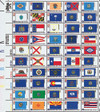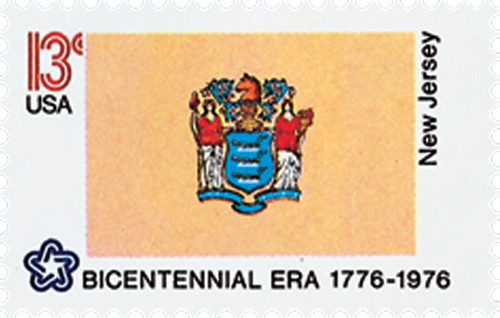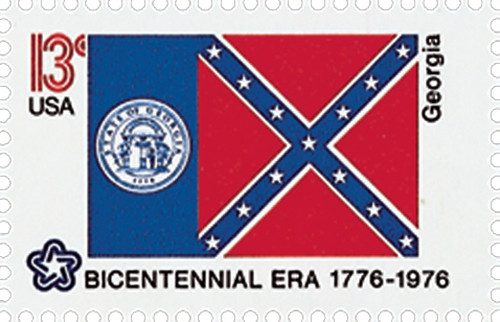
# 1633-82 - 1976 13c State Flags
U.S. 1633-82
1976 State Flags
American Bicentennial Series
• First time a sheet 50 had all different stamp designs
• Part of the American Bicentennial Series
Stamp Category: Commemorative
Series: American Bicentennial Series
Value: 13¢ First-class postage rate
First Day of Issue: February 23, 1976
First Day City(s): Washington, DC
Quantity Issued: 8,720,100 (panes of 50)
Printed by: Bureau of Engraving and Printing
Printing Method: Photogravure
Format: Sheet of 50
Perforations: 11
Why the stamp was issued:
The United States Postal Service celebrated the American Bicentennial with a full pane of the Union’s fifty state flags.
About the stamp design:
Each stamp is pictured horizontal and depicts the 50 state flags in order of when they became official states of America. The pane starts with Delaware which became the first state on December 7, 1787 and ends with Hawaii which was the last state.
About the printing process:
Printed by the Bureau of Engraving and Printing on their seven-color Andreotti gravure press (601) which was their work horse for multicolored stamps.
About the American Bicentennial Series:
In the 1970s, America celebrated its 200th anniversary with hundreds of national events commemorating the heroes and historic events that led to our nation’s independence from Great Britain. The U.S. Postal Service issued 113 commemorative stamps over a six-year period in honor of the U.S. bicentennial, beginning with the American Revolution Bicentennial Commission Emblem stamp (U.S. #1432). As a group, the Bicentennial Series chronicles one of our nation’s most important chapters, and remembers the events and patriots who made the U.S. a world model for liberty.
Several of the stamps honored colonial life – craftsmen and communication. Other stamps honored important battles including Lexington and Concord, Bunker Hill, and Saratoga. Significant events such as the Boston Tea Party, the meeting of the First Continental Congress, and the Declaration of Independence were featured as well. The stamps also honored many significant people such as George Washington, Sybil Ludington, Salem Poor, and the Marquis de Lafayette.
Many of the stamps feature classic artwork. For instance, the set of four souvenir sheets picture important events recreated by noted artists such as John Trumbull. The Bicentennial Series also includes an important US postal first – the first 50-stamp se-tenant – featuring all 50 state flags. The format proved to be popular with collectors, and has been repeated many times since.
The American Bicentennial Series is packed with important US history – it tells the story of our nation’s fight for independence through stamps.
History the stamp represents:
On February 23, 1976, the USPS issued its first 50-stamp se-tenant.
Up until the 1960s, when the US produced stamps, all the stamps on a sheet usually had the same design. They first strayed from this format in 1964 when the US Post Office issued its first-ever se-tenant.
Se-tenant is a French phrase meaning “joined together.” When referring to stamps, se-tenants are blocks of stamps that are printed on the same sheet with different designs. The first US se-tenant was the Christmas issue of 1964, which included four different stamps. The format proved popular, and in the coming years, the post office continued to issue stamps in this format.
In the early 1970s, the US was preparing to celebrate the bicentennial. All over the country homes and businesses were decked out in red, white, and blue. Small towns and big cities held parades and festivities to mark the occasion. The USPS was also working on an extensive series of Bicentennial stamps honoring battles, heroes, and other topics relating to the era.
One of the most popular issues in the Bicentennial Series was the State Flags se-tenant. Issued on February 23, 1976, it was the first US se-tenant to include 50 different stamps. It features the designs of every US state flag and each stamp includes the Bicentennial logo. The stamps were arranged on the sheet in the same order the states were admitted into the Union.
U.S. 1633-82
1976 State Flags
American Bicentennial Series
• First time a sheet 50 had all different stamp designs
• Part of the American Bicentennial Series
Stamp Category: Commemorative
Series: American Bicentennial Series
Value: 13¢ First-class postage rate
First Day of Issue: February 23, 1976
First Day City(s): Washington, DC
Quantity Issued: 8,720,100 (panes of 50)
Printed by: Bureau of Engraving and Printing
Printing Method: Photogravure
Format: Sheet of 50
Perforations: 11
Why the stamp was issued:
The United States Postal Service celebrated the American Bicentennial with a full pane of the Union’s fifty state flags.
About the stamp design:
Each stamp is pictured horizontal and depicts the 50 state flags in order of when they became official states of America. The pane starts with Delaware which became the first state on December 7, 1787 and ends with Hawaii which was the last state.
About the printing process:
Printed by the Bureau of Engraving and Printing on their seven-color Andreotti gravure press (601) which was their work horse for multicolored stamps.
About the American Bicentennial Series:
In the 1970s, America celebrated its 200th anniversary with hundreds of national events commemorating the heroes and historic events that led to our nation’s independence from Great Britain. The U.S. Postal Service issued 113 commemorative stamps over a six-year period in honor of the U.S. bicentennial, beginning with the American Revolution Bicentennial Commission Emblem stamp (U.S. #1432). As a group, the Bicentennial Series chronicles one of our nation’s most important chapters, and remembers the events and patriots who made the U.S. a world model for liberty.
Several of the stamps honored colonial life – craftsmen and communication. Other stamps honored important battles including Lexington and Concord, Bunker Hill, and Saratoga. Significant events such as the Boston Tea Party, the meeting of the First Continental Congress, and the Declaration of Independence were featured as well. The stamps also honored many significant people such as George Washington, Sybil Ludington, Salem Poor, and the Marquis de Lafayette.
Many of the stamps feature classic artwork. For instance, the set of four souvenir sheets picture important events recreated by noted artists such as John Trumbull. The Bicentennial Series also includes an important US postal first – the first 50-stamp se-tenant – featuring all 50 state flags. The format proved to be popular with collectors, and has been repeated many times since.
The American Bicentennial Series is packed with important US history – it tells the story of our nation’s fight for independence through stamps.
History the stamp represents:
On February 23, 1976, the USPS issued its first 50-stamp se-tenant.
Up until the 1960s, when the US produced stamps, all the stamps on a sheet usually had the same design. They first strayed from this format in 1964 when the US Post Office issued its first-ever se-tenant.
Se-tenant is a French phrase meaning “joined together.” When referring to stamps, se-tenants are blocks of stamps that are printed on the same sheet with different designs. The first US se-tenant was the Christmas issue of 1964, which included four different stamps. The format proved popular, and in the coming years, the post office continued to issue stamps in this format.
In the early 1970s, the US was preparing to celebrate the bicentennial. All over the country homes and businesses were decked out in red, white, and blue. Small towns and big cities held parades and festivities to mark the occasion. The USPS was also working on an extensive series of Bicentennial stamps honoring battles, heroes, and other topics relating to the era.
One of the most popular issues in the Bicentennial Series was the State Flags se-tenant. Issued on February 23, 1976, it was the first US se-tenant to include 50 different stamps. It features the designs of every US state flag and each stamp includes the Bicentennial logo. The stamps were arranged on the sheet in the same order the states were admitted into the Union.

















